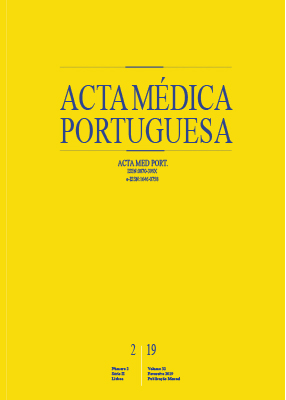Anaphylactic Reactions in the Emergency Department of a Portuguese Tertiary Hospital: Clinical Characterization and Disease Notification
DOI:
https://doi.org/10.20344/amp.10820Keywords:
Anaphylaxis/epidemiology, Anaphylaxis/etiology, Emergency Service, HospitalAbstract
Introduction: Anaphylaxis is significantly underdiagnosed, and the medical community’s knowledge about it is precarious. The aim of this study is to characterize the patient population and the Emergency Department approach of anaphylaxis.
Material and Methods: Retrospective study of adult patients attending the Emergency Department of a tertiary care Portuguese hospital, over a year, with anaphylaxis. Data were obtained from each patient’s clinical records and anonymized. A questionnaire evaluating knowledge about the notification of anaphylaxis was applied to Emergency Department physicians.
Results: The study included 69 patients. Cutaneous (97%) and respiratory features (80%) were most prevalent; 22% of patients presented with shock or related symptoms. There were no reported biphasic reactions or deaths. The likely allergen was identified in 73%, most commonly food; 12% of reactions were related to a previously known allergen. Epinephrine was administered to 15%. Referral to an Immunoallergologist was done in 36% of patients, and 10% received or already possessed an epinephrine autoinjector. Among six parameters recommended for auditing clinical practice, 70% of cases fulfilled less than half. Only 13% of physicians knew it was mandatory to register all cases in the Portuguese Catalogue of Allergies and Other Adverse Reactions, and only 4% knew how to do it; regarding notification to the National Authority of Medicines and Health Products results were slightly better.
Discussion: Many patients with anaphylaxis present to the Emergency Department every year, and their clinical approach is not in agreement with national guidelines.
Conclusion: An educational program to increase medical awareness of the national guidelines and mandatory notification of all anaphylactic reactions should be implemented.
Downloads
Downloads
Published
How to Cite
Issue
Section
License
All the articles published in the AMP are open access and comply with the requirements of funding agencies or academic institutions. The AMP is governed by the terms of the Creative Commons ‘Attribution – Non-Commercial Use - (CC-BY-NC)’ license, regarding the use by third parties.
It is the author’s responsibility to obtain approval for the reproduction of figures, tables, etc. from other publications.
Upon acceptance of an article for publication, the authors will be asked to complete the ICMJE “Copyright Liability and Copyright Sharing Statement “(http://www.actamedicaportuguesa.com/info/AMP-NormasPublicacao.pdf) and the “Declaration of Potential Conflicts of Interest” (http:// www.icmje.org/conflicts-of-interest). An e-mail will be sent to the corresponding author to acknowledge receipt of the manuscript.
After publication, the authors are authorised to make their articles available in repositories of their institutions of origin, as long as they always mention where they were published and according to the Creative Commons license.









